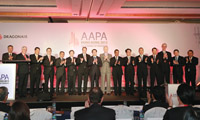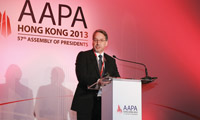Main Story
INFRASTRUCTURE ... AND YET MORE INFRASTRUCTURE
Airline chiefs at the 57th Association of Asia Pacific Airlines (AAPA) Assembly of Presidents warned airport and air traffic infrastructure shortfalls threaten to curtail growth.
December 1st 2013
Airline growth would stall and the economic advantages of an expanded aviation sector on the region’s Gross Domestic Product (GDP) would be eroded unless governments speeded up investment in all strategic sectors of ground facilities and ATM, said AAPA director general, Andrew Herdman, at the AAPA Assembly of Presidents, held this year in Hong Kong. Read More »
 |
| Opening ceremony of the AAPA Assembly of Presidents |
“The danger with infrastructure is it doesn’t just hold you back, it’s just a brick wall,” he said. “If you don’t have the infrastructure, if there are no more slots, it doesn’t matter how many aircraft you buy. There comes a point when you are up against the wall with airport capacity or bottlenecking of busy airspace corridors. This issue is important in ensuring the industry delivers its potential growth,” he said.
The Asia-Pacific has been ahead of the game and forward looking, Herdman said, but “there are clear signs we are behind the curve [now]”. “We have severe congestion in China because of rapid growth in Chinese air traffic. There are chronic delays. They drive down efficiency and destroy customer service. Once you’re into that tight spot it’s very hard to fight your way out of it,” Herdman said.
Indonesia, the Philippines and other countries in the region have grown very rapidly and outpaced the growth in runway capacity, airport terminals and airspace management. Herdman explained that when the industry grows at 5% annually, air traffic doubles every 15 years. If it grows at 6%, traffic doubles every nine years. But Asian countries like China, Indonesia and the Philippines are seeing 12% annual growth, which equates to a doubling of traffic every six years, he said.
“The growth will only be successfully accommodated if infrastructure keeps up. It’s no good just buying aircraft. You need airports, runways and terminal capacity. You need air space and efficient airspace management. The runways you have today need to double in six years. The pilots of 2013 have to double in six years,” the director general said.
“Given the long development period for infrastructure, planning must be done in appropriate longer term time scales. We must ask: can we double capacity, not can we add 10% and so on?”
 |
| Its Love: Dragonair chairman and host of the Hong Kong Association of Asia-Pacific Airlines Assembly of Presidents, John Slosar, with soul brother, Beach Boy Mike Love. The legendary Beach Boys performed at the annual AAPA Assembly of Presidents dinner in November |
As an example, at Manila’s Ninoy Aquino International Airport (NAIA) on one day in November (pre-Tyhoon Haiyan) seven scheduled flights were diverted to Clark International Airport because of congestion. They were mostly domestic flights, but also included an Etihad B777 flight from Abu Dhabi and a Singapore Airlines service from its home base city.
Concern about infrastructure constraints was underscored by Garuda Indonesia president, Emirsyah Satar, during the CEO panel at the Assembly. Already rapid air traffic growth in Indonesia has produced constraints on growth, with congestion posing a bigger threat to Garuda and its partners than low-cost carrier (LCC) competition, he said.
Indonesia flew 55 million passengers in its latest fiscal year, with annual traffic forecast to increase very rapidly to 120 million air travelers annually. The infrastructure is not in place to cope with that growth, he told AAPA delegates.
“The growth is going to be there and the market is going to be there, but the biggest issue for us is infrastructure. Garuda will increase its fleet from 131 in 2013 to 400 aircraft by 2025, but it has already been affected by lagging infrastructure development.”
Delegates heard that several times a week the airline has to tow eight to ten aircraft into its own hangars at Jakarta’s Soekarno-Hatta International because there are not enough parking spaces near the terminal. It has had to delay the launch of its first direct flights to London by six months, until May next year, because the runways and apron at Jakarta are not strong enough to support a London-bound B777-300ER at its maximum take-off weight.
“Passenger growth (in Indonesia) is going to be one-and-a-half to two times GDP growth,” said Satar. “Indonesia is still growing. In the last six years, passengers carried reached double digits. If you look at Indonesia, the growth of the regional hubs and the mid-sized cities will be phenomenal. There is rising demand and the airports will be built there. The challenge is how fast will be the execution of these plans.”
| China carriers to join AAPA? At least one Chinese airline, and possibly more, are likely to join the Association of Asia-Pacific Airlines (AAPA) in 2014. An influential delegate at the annual AAPA Assembly of Presidents in November was Li Jiangmin, executive vice chairman of the China Air Transport Association (CATA), which represents the major Chinese carriers. CATA was the voice of Beijing’s unequivocal opposition to the European Union’s Emissions Trading Scheme. A sole delegate at the AAPA Assembly in Kuala Lumpur in 2012, this time around Mr. Li was not alone. Ma Ling, a vice managing director of Beijing-based national flag carrier, Air China, and Tang Bing, executive vice president of Shanghai-based China Eastern Airlines, also attended the Hong Kong AAPA gathering. Chinese sources told Orient Aviation there was a real possibility at least some of the country’s major airlines may sign-up with the AAPA. The sources said the “Taiwanese question” was no longer an issue and that there was a feeling in Beijing that China must be a part of a unified regional voice on major aviation issues. AAPA director general, Andrew Herdman, wasn’t giving anything away on the matter, commenting only that he sincerely hoped Chinese carriers would join the AAPA. |
Patrick Yeung, chief executive of Dragonair, which has a significant network into China, said rapid growth and expansion on the Mainland were causing bottlenecks at airports. “Air traffic control is notorious [in China] even though there have been recent improvements by the Civil Aviation Administration of China (CAAC) and the country’s related aviation regulators,” he said.
“It is still a big challenge for us. Passengers are affected and resources are wasted. They have done some great things building up infrastructure, but there are still many challenges.”
Hong Kong, which is faced with severe long-term overcrowding at its award-winning airport, will not have its third runway until 2023. This target will only be met if an environmental impact study is completed in 2014 and construction commences without political interference.
 |
| 'The danger with infrastructure is that it doesn’t just hold you back. It’s a brick wall. If you don’t have the infrastructure, if there are no more slots, it does not matter how many aircraft you buy ' |
| Andrew Herdman Director General AAPA |
Tommy Leung, general manager projects Airport Authority Hong Kong, said the [Hong Kong] Civil Aviation Department (CAD) had a ceiling of 68 movements per hour at its airport and the airport was operating at 65. “You can see we are gradually approaching the limit of the two runway system,” he said.
When the airport opened in 1998, it handled 28 million passengers annually. This year it will hit 60 million. Leung explained a 2009 Master Plan had forecast the two runway system would be saturated by 2019 or 2020, but traffic growth is three years ahead of forecasts. “We are in trouble if we deliver the third runway in accordance with our original master plan. We need to hurry up,” he said. Dragonair’s Yeung said slots were not just an issue in Hong Kong. “It’s the same in China and elsewhere in Asia,” he said.
John Byerly, formerly the U.S. government’s longest serving deputy assistant secretary for transportation affairs and best known for his groundbreaking work on the US–EU Open Skies agreement, said there is discussion in China about building scores of new airports and expanding existing facilities, a strategy highlighted at a recent aviation conference in Beijing.
“One of the factors that came up was the dearth of staff, in particular pilots, and the search for ways to meet that challenge. It is a country that has, and will continue to have, massive and growing demand,” he said. “There was a clear awareness in Beijing that there is a big challenge ahead for accommodating airline growth. They are committing resources,” he said.
“The growth is so phenomenal that I am a little bit hesitant to say they are going to make it. It’s difficult with over a billion people. Yes, there will be huge expansion in China. They will do their best. Can they deal with the airspace issue, the military/civilian conflict (there are seven military air space zones in China) and who controls it? This is critical to the number of slots available at impacted airports.
“There is a philosophy [in China] which is the right philosophy. It is liberalization. It is building infrastructure. It is doing our best. Now everything is in the execution. That’s going to be a big challenge.”
One bright spot across the region, according to Byerly, is Japan. “We have seen an absolute revolution in thinking in Japan and Tokyo. You’ve got expansion of Haneda with a fourth runway and talk about a fifth. You have massive expansion of slot capacity at Narita. Admittedly, Japanese authorities were exceptionally concerned about expansion, but they are adding 50% capacity and there is discussion about increasing that number.
| 'Strength lies in collective unity, and if the Asia-Pacific wants to pay a bigger role in global [aviation] discussions, it must speak with one voice. We need to set aside personal interests and political differences and work together on issues of common concern' |
| 2013 AAPA Assembly of Presidents resolution |
“So for a country that has a stagnant or even declining population, Japan is taking steps to improve infrastructure. That’s great.”
At the assembly, AAPA bosses passed a resolution calling on governments to ensure that air traffic management capacity keeps pace with commercial air traffic growth. They urged working with military authorities, where necessary, to reduce airspace usage limitations and regulations.
“Asian governments need to commit to a program of investments in efficient air traffic management, prompt implementation of recognized international standards and procedures and best operational practices in order to avoid unnecessary congestion, delays and inconvenience to the travelling public,” said the resolution.
Not surprisingly, the decision of the European Commission (EC) to re-start the clock on charging foreign airlines for their emissions – though this time within European airspace – raised the temperature at the Assembly. “Even after the 38th ICAO (International Civil Aviation Organization) Assembly’s success in securing a global agreement to develop a market-based measure to address aviation emissions, the proposal to extend the EU ETS to European airspace has been met with a mixture of incredulity and disbelief,” said Herdman.
“To these bureaucrats I can only say: Stop for a moment and think. Do you really want to reignite a trade war with your international partners? We can only hope common sense will prevail, that Europe will reconsider and add its weight and full support to the agreement made at ICAO.
“The AAPA is absolutely convinced the interests of Asia-Pacific carriers, and the industry as a whole, are best served by supporting a global solution and not a patchwork of national or regional schemes that will only distort the market,” Herdman said.
Byerly said he was “really upset” the Europeans simply ignored the results of the ICAO Assembly. “It is not going to do anything to affect global warming. It’s going to have no effect on the frequency of typhoons, hurricanes or other events. It’s purely political. My guess is that many countries that stood up to Europe – China, India, Russia, South Africa – will probably stand up again and they won’t be bought off,” he said.
“The international community spoke at ICAO. Europe has decided to do its own thing all over again. I can’t say I’m totally surprised. It’s just a wrong-headed decision. With the opposition it has provoked, I hope there will be another ‘stop the clock’ or ‘just turn the clock off’ decision and that everyone gets on with the ICAO program.”
He said Asia was speaking with one voice on the issue and was clearly saying: “hell no, we won’t go, we will not accept this”. “It can be done politely and diplomatically but there should be a clear message from the region as a whole,” he said.
Asia-Pacific airlines delivered a strong performance in the last 12 months, a collective result Herdman said was all the more remarkable since several countries have introduced a swathe of regulations and taxes that have impacted negatively on industry growth.
A resolution passed at the Hong Kong Assembly asked the region’s governments to carefully consider the overall economic effects of putting more financial strain on the travelling public and the aviation industry by imposing more aviation levies.
“The Association calls on governments to adhere to ICAO policies on taxation and ensure its recommendations are followed by all relevant taxation authorities within those governments. Finally, it calls on governments to avoid imposing unjustified or discriminatory taxes on international aviation, thereby imposing unwarranted costs on global tourism and trade,” it said. Herdman said visitor arrival taxes were being considered by Thailand and Indonesia, which were examples of impediments to growth.
The AAPA repeated a call made in 2012, which pointed out that despite the commercial success of Asian airlines, the global policy-making process is largely influenced by the U.S. and the EU.
“This must change. Global regulatory institutions must evolve to reflect modern economic and political realities in a rapidly changing world. Diversity in the Asia-Pacific and the absence of a regional regulator sometimes hold our region back from having a larger voice at the policy-making table.
“Strength lies in collective unity, and if Asia wishes to play a bigger role in global discussions, it must speak with one voice. We need to set aside personal interests and political differences and work together on issues of common concern,” the AAPA said.
| AAPA expands to India The Association of Asia-Pacific Airlines has widened its sphere of influence. Previously, membership was limited to airlines within specific time zones in the Asia-Pacific, effectively creating a western boundary that ended at the Bay of Bengal. At the Hong Kong AAPA Assembly, new borders were announced that expanded eligibility for AAPA membership to the Indian sub-continent, which would allow Indian, Pakistani, Sri Lankan and Bangladeshi airlines to become AAPA members. |